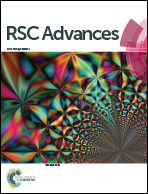A red-emitting Sr3La(1−x)Eux(AlO)3(BO3)4 phosphor with high thermal stability and color purity for near-UV-excited wLEDs†
Abstract
A high efficiency red-emitting Eu3+ doped Sr3La(AlO)3(BO3)4 phosphor has been calcined successfully through a traditional solid-state method, and the photoluminescence and cathode-luminescence properties of samples are investigated in detail. The result of density functional theory (DFT) calculation shows that the Sr3La(AlO)3(BO3)4 host lattice has an indirect band gap. The broad excitation ranges from 200 nm to 500 nm, especially the strongest excitation located in the near ultraviolet (near-UV) region, suggests that the phosphor can match well with not only blue LED chips but also near-UV LED chips. Besides, the phosphor can emit bright red light peaking at 596, 618, 655 and 706 nm under either near-UV or blue light excitation and the internal quantum efficiency can reach 40%. The temperature-dependent PL properties and calculation of color purity show that the phosphor has an excellent thermal stability and outstanding color stability. Ultimately, by employing Sr3La(AlO)3(BO3)4:Eu3+ phosphor as a red light component, a stable warm white light emission is obtained with Ra = 80, CIE = (0.3443, 0.2903) and CCT = 4680 K. These results indicate that red Sr3La(AlO)3(BO3)4:Eu3+ phosphor may have a great potential for wLEDs with fantastic properties.



 Please wait while we load your content...
Please wait while we load your content...